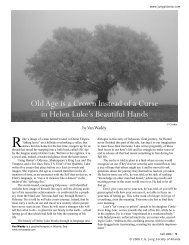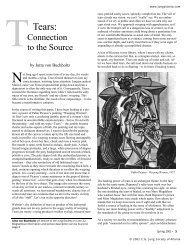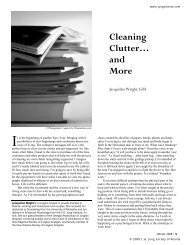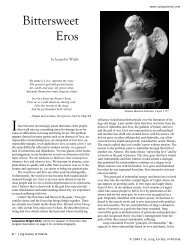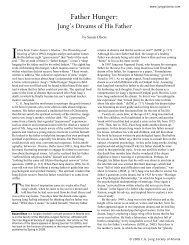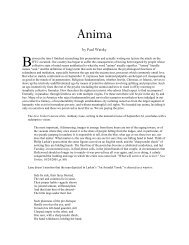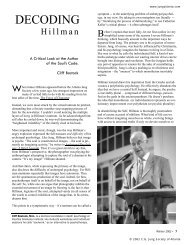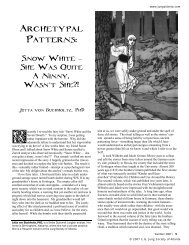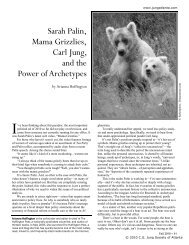Hermes and the Creation of Space - C.G. Jung Society of Atlanta
Hermes and the Creation of Space - C.G. Jung Society of Atlanta
Hermes and the Creation of Space - C.G. Jung Society of Atlanta
You also want an ePaper? Increase the reach of your titles
YUMPU automatically turns print PDFs into web optimized ePapers that Google loves.
The classic statue <strong>of</strong> <strong>Hermes</strong>, called a Herm, was a later development. It was a quadratic pillar<br />
usually about 6 feet high resting on a square base, topped with a bearded head <strong>and</strong> fronted with an<br />
erect phallus. Herms first appeared under rule <strong>of</strong> <strong>the</strong> tyrant Hipparchus around 520-524 B.C., who<br />
had <strong>the</strong>se figures set up as boundary markers throughout Greece. Oddly, <strong>the</strong> Herm has none <strong>of</strong> <strong>the</strong><br />
qualities <strong>of</strong> movement <strong>and</strong> lightness usually associated with <strong>the</strong> spirit <strong>of</strong> <strong>Hermes</strong>, <strong>and</strong> <strong>the</strong> head<br />
atop it is that <strong>of</strong> an older, bearded man. It is anything but youthful, dynamic <strong>and</strong> air-like, although<br />
it is quite charming in its own way. A marker <strong>of</strong> boundaries, it is geometric <strong>and</strong> hard-edged, exact<br />
<strong>and</strong> defining. Hipparchus set <strong>the</strong>se in place, according to Brown, in order to "integrate <strong>the</strong> cult <strong>of</strong><br />
<strong>Hermes</strong> into urban <strong>and</strong> political life <strong>of</strong> <strong>the</strong> city-state" (p. 113). This brought <strong>Hermes</strong> more centrally<br />
into Greek consciousness. A Herm was also placed at <strong>the</strong> Propyleia (entrance) to sacred precincts<br />
<strong>and</strong> temples, where he marked <strong>the</strong> boundary <strong>of</strong> <strong>the</strong> temenos. With this development, liminality<br />
moved in closer to centrality; everywhere <strong>Hermes</strong> now stood at boundaries <strong>and</strong> defined spaces,<br />
referring <strong>the</strong> citizen to horizontal <strong>and</strong> vertical dimensions <strong>of</strong> existence.<br />
Archetypally, we can see in <strong>the</strong> image <strong>of</strong> <strong>Hermes</strong> a mythical statement <strong>of</strong> <strong>the</strong> psyche's innate<br />
tendency to give definition to perceptual <strong>and</strong> mental horizons, to mark edges, to define spaces.<br />
Originally <strong>Hermes</strong> stood at <strong>the</strong> edge <strong>of</strong> known space, a pile <strong>of</strong> stones at <strong>the</strong> boundary. His sign<br />
marked <strong>the</strong> limit <strong>of</strong> consciousness. Beyond <strong>the</strong> boundary lies <strong>the</strong> unknown, <strong>the</strong> uncanny, <strong>the</strong><br />
dangerous, <strong>the</strong> unconscious. When markers are created <strong>and</strong> limits set, however, curiosity <strong>and</strong><br />
explorativeness are also excited <strong>and</strong> new spaces for exploration <strong>and</strong> discovery invite <strong>the</strong> bold <strong>and</strong><br />
courageous traveler. If <strong>Hermes</strong> marks <strong>the</strong> boundary between conscious <strong>and</strong> unconscious, we have<br />
to realize that this boundary is always shifting <strong>and</strong> in flux; it is mercurial. Background <strong>and</strong><br />
foreground may instantaneously reverse too, <strong>and</strong> generate new perceptions, novel insights.<br />
Within <strong>the</strong> area <strong>of</strong> <strong>the</strong> known, containers take shape which are reserved for specific types <strong>of</strong><br />
human activity, while beyond <strong>the</strong>m lies <strong>the</strong> "o<strong>the</strong>r," <strong>the</strong> foreign (even if only temporarily), <strong>the</strong><br />
taboo, <strong>the</strong> forbidden, <strong>the</strong> unclean. <strong>Hermes</strong> st<strong>and</strong>ing at <strong>the</strong> boundary marks a psychological <strong>and</strong><br />
sometimes a moral limit <strong>and</strong> calls special attention to <strong>the</strong> space being entered or left. When he first<br />
appears, he may create a new space by dividing a vast horizon into <strong>the</strong> "here" <strong>and</strong> <strong>the</strong> "beyond,"<br />
<strong>and</strong> thus he creates both consciousness <strong>and</strong> a new unconscious. His intervention in <strong>the</strong> perceptual<br />
<strong>and</strong> psychological field creates new possibilities for consciousness, also new edges <strong>and</strong> boundaries<br />
beyond which lie <strong>the</strong> mysterious "o<strong>the</strong>rs." When he disappears, <strong>the</strong>re is a loss <strong>of</strong> identity <strong>and</strong><br />
definition.<br />
Boundaries, it must be noted, are basic to human perception, <strong>and</strong> <strong>the</strong>ir creation <strong>and</strong> maintenance<br />
<strong>the</strong>refore are archetypal. Boundaries create categories for thought <strong>and</strong> behavior. Fences not only<br />
make good neighbors; fences make neighbors, period. Without boundaries <strong>the</strong>re are no object<br />
relations - in a sense <strong>the</strong>re are no objects; without definitions <strong>the</strong>re can be no thought; <strong>the</strong> world is<br />
ouboboric, undifferentiated, pleromatic. The appearance <strong>of</strong> herma - an epiphany <strong>of</strong> <strong>Hermes</strong> -<br />
represents <strong>the</strong> introduction <strong>of</strong> <strong>the</strong> differentiating principle into <strong>the</strong> pleromatic void.<br />
In Seven Sermons to <strong>the</strong> Dead (1989, pp. 378-90), <strong>Jung</strong> calls this principle creatura, <strong>the</strong> principle<br />
<strong>of</strong> distinctiveness:<br />
Distinctiveness is creatura. It is distinct. Distinctiveness is its essence, <strong>and</strong> <strong>the</strong>refore it<br />
distinguisheth. Therefore man discriminateth because his nature is distinctiveness.... Our very<br />
nature is distinctiveness....<strong>the</strong> natural striving <strong>of</strong> <strong>the</strong> creature goeth towards distinctiveness,<br />
fighteth against primeval, perilous sameness. This is called <strong>the</strong> PRINCIPIUM<br />
INDIVIDUATIONIS. This principle is <strong>the</strong> essence <strong>of</strong> <strong>the</strong> creature.<br />
<strong>Hermes</strong> is <strong>the</strong> psyche etching lines into <strong>the</strong> panes <strong>of</strong> perception.<br />
What does it add to say that this function <strong>of</strong> making distinctions is archetypal <strong>and</strong> not simply an<br />
artifact <strong>of</strong> ego-functioning? It says that <strong>the</strong> ego actually depends upon <strong>the</strong> psyche in order to




